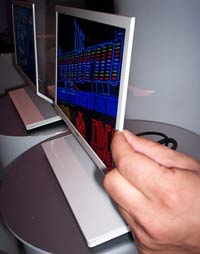Sony announces first television with an organic light-emitting diode display
Sony, the world's second-biggest maker of consumer electronics, displayed Monday the first television for the commercial market with an organic light-emitting diode display.

The 11-inch display TV called XEL-1 - set to go on sale Dec. 1 in Japan for 200,000 yen (US$1,700; EUR1,200) - measures just 3 millimeters (0.12 inches) thick, about the same as a coin.
Plans for overseas sales are still undecided, Sony Corp. said. Production is set for 2,000 units a month, it said.
The XEL-1 uses new light-emitting display technology called OLED based on electroluminescent organic materials to deliver clear image quality, even for the color black and a metallic sheen.
Sony officials said the technology is superior to liquid crystal and plasma displays, now widely used in thin TVs, because OLED technology uses materials that emit light on their own and don't require a back light.
It can also relay video 1,000 times faster than liquid crystal displays, eliminating the blur of LCD TV imagery, and reduces energy consumption by 40 percent, according to Sony.
Sony, which has movie and music as well as video-game businesses, fell behind rivals in display TVs and now makes liquid crystal TVs in a partnership with rival Samsung Electronics Co. of South Korea.
Sony no longer makes plasma display TVs, a market dominated by Japanese rival Matsushita Electric Industrial Co., maker of Panasonic products.
Sony President Ryoji Chubachi, in a rare appearance for a product launch, said the new TV answers criticism that Sony had failed to translate its technological prowess into attractive consumer products.
"The world's first OLED TV is a symbol of the rebirth of Sony with its superb technology," he told reporters at Tokyo headquarters.
The new TV was unveiled showing video of skyscraper lights at night, the shimmery fish skin of sushi and sparkling liquor being poured into a glass to highlight its vivid imagery.
Sony Executive Deputy President Katsumi Ihara said the new TV's importance may be more about corporate image than real sales. OLED TV's won't replace LCD TVs until they become available in bigger sizes and cheaper pricing, he said.
Prices have plunged in thin TVs, and a small LCD TV sells for about the tenth of the price of the XEL-1, although prices vary.
Other companies, including Samsung, are working on OLED technology. Besides pricing, another obstacle to putting OLED in a commercial product has been its life span.
The new OLED TV will last 30,000 hours, about 10 years for someone using the TV eight hours a day. An equivalent Sony LCD TV lasts twice that long, Sony said.
Ihara said new products are in the works to take advantage of the technology. When asked for specifics, he replied with a smile that they were "corporate secrets."
Subscribe to Pravda.Ru Telegram channel, Facebook, RSS!


